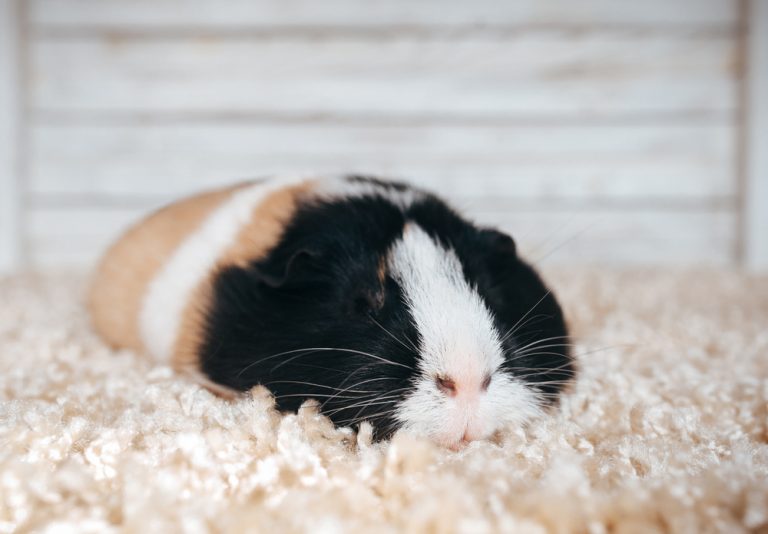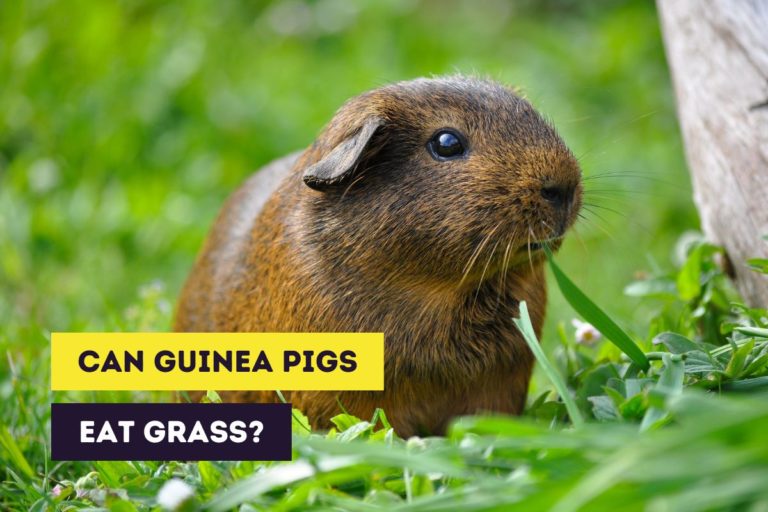Can Guinea Pigs Live Outside?
When you’re considering getting a guinea pig, you’re probably – at least at first – not considering its future housing inside and/or outside. But adequate housing is important for all pets, and more so for small pets like guinea pigs.
Most pocket pets, like hamsters and chinchillas, are kept inside in a large enough cage. But there are some other rodents that can be kept outside, like rabbits. Not all pocket pets can be kept outside and it’s important to know if a pet can be kept in an outside cage or not.
Can guinea pigs live outside? Guinea pigs can be kept outside in an outdoor cage under the condition that the temperatures are not too high or too low. They can’t tolerate heat or cold that well and will also need protection from potential predators like cats and foxes.
So, guinea pigs are sensitive creatures that don’t tolerate temperature changes well and also are best kept in an environment with a normal “room temperatures”, such as humans also like. They also are prey animals that can become the target of a lot of different animals. So, keeping a guinea pig outside requires some planning and thought.
In this article, you’ll learn everything there is to know about keeping a guinea pig in an outside cage or hutch. I’ll also get into the possible dangers and give you some tips and tricks to create the perfect outside environment for your guinea pig.
This site contains affiliate links to products we recommend and use ourselves. We may receive a commission for purchases that you make through these links. If you’re interested in learning more about our affiliate links, please visit our (affiliate) disclaimer.
Why Is It (Not) a Good Idea to Keep Guinea Pigs Outside?
Temperature sensitivity of guinea pigs
Guinea pigs are really sensitive too low and high temperatures. It’s advised to keep guinea pigs in an environment with a temperature between 16 and 24 degrees Celcius. If the temperature drops below 16 degrees Celsius, your guinea pig can get a cold. If the temperature rises above 24 degrees Celsius, you risk that your guinea pig gets a heatstroke. Guinea pigs can’t sweat so be aware that they aren’t exposed to high temperatures!
Temperatures between 16 and 24 degrees Celsius are normal room temperatures. This is the reason why most guinea pigs are kept indoors in a cage where you can control the temperature and also have a steady temperature – guinea pigs don’t like sudden temperature changes.
You’ll need to take into consideration this temperature sensitivity if you want to keep your guinea pig outside. If you live in a region where temperatures are too hot or too cold you’ll need to keep your guinea pig inside in a cage. However, when you live in a region with a mild climate you can house your guinea pig outside (with some extra safety measures).
Bonding with your guinea pig
Guinea pigs love too live inside and cuddle with you. But when you keep your guinea pigs outside you might not cuddle as much with them. You might just give them food and clean their cage but not take enough cuddle time. This might hinder the bonding process.
So, if you want to cuddle a lot with your guinea pig, you might want to keep your little pet inside.
Dangers of keeping a guinea pig outside
If you keep a guinea pig outside temporarily or all-year long you’ll need to protect them from a few dangers that might hurt your little pet:
- predators
- poisonous plants
- weedkiller and insecticides
- weather
Predators
There are a lot of animals that can be a threat to your little pet. The most common predators that can take a bite in your guinea pig are cats, predator birds, and foxes. When you keep your guinea pig outside you’ll need to protect them from these predators somehow. The best way to do this is to get a hutch with a roof.
Also, keep an eye on them when you let them out the hutch to let them eat some grass or have a little bit of exercise.
Poisonous plants
You might have a beautiful garden with a lot of different plants but these plants can be poisonous for your guinea pig. The following plants are known to be poisonous for guinea pigs:
- Buttercups (Ranunculus)
- Deadly nightshade (Atropa belladonna)
- Scarlet Pimpernel (Anagallis arvensis)
- Tulips (Tulipa)
- Lily of the valley (Convallaria majalis)
- Rhododendrons (Rhododendron)
If you’ve got any of these plants in your home or garden, you should not leave your guinea pig in the vicinity of them.
Weedkiller and insecticides
If you let your guinea pigs on the grass you have to be careful that you didn’t spray weedkiller or insecticides on the grass or plants. Guinea pigs love to eat grass and plants and can ingest the harmful products this way.
Weather
Guinea pigs don’t like high or low temperatures and are best kept in an environment that’s between 16 and 24 degrees Celsius. If the temperature outside is too high (summer) or too low (winter) you’ll need to make sure that they can be kept in a cage inside where temperatures are more suitable.
Bad weather, like rain and thunder, can also scare your guinea pig and make it sick. A hutch needs to have a place where your guinea pig can hide and find shelter against the rain.
How to Keep a Guinea Pig Outside?
There are basically two ways to keep guinea pigs outside. You can use an outside cage, also called a hutch, or you can use a run. The hutch is a permanent solution that can be used all year long while a run is more of a temporary house that can be used in spring and summer.
Keeping a guinea pig in an outside hutch
Hutch basics
A hutch is a common name for an outside housing. Hutches come in all shapes and sizes. You can go crazy and buy the most luxurious outside mansion for your guinea pig if you don’t really have a fixed budget. But most of us have a limited budget and maybe you even want to build the hutch yourself. This is entirely possible and even not that difficult.
A hutch for one guinea pig should have a surface floor of at least 70 by 50 centimeters and have a height of 45 centimeters. If you house more than one guinea pig or house long-haired guinea pigs your hutch should be larger. If you’re not sure if the hutch is large enough for the number of guinea pigs you want to house, ask advice in the pet shop.
Winter-proofing
In extremely cold weather conditions it’s always necessary to keep your guinea pigs warm and the best thing you can do is house them indoors in such conditions. You can do this by placing the hutch indoors or by relocating your guinea pigs to a cage in your home.
If you live in a country with a mild climate, you will still need to make sure that the guinea pigs aren’t exposed to cold temperatures in the winter. Guinea pigs can get sick fast and it’s a good idea to winter-proof the hutch with the following measures:
- provide enough bedding material: hay is an essential material in hutches and in the winter they’ll definitely need it to stay warm. Give enough hay and remove any wet hay. Change the bedding at least every day, especially if it’s cold and damp outside.
- refresh the water bottle daily: the water in a water bottle can freeze when temperatures drop below freezing. There isn’t a lot you can do about this except for checking each day that the water isn’t frozen and that the bottle can still be used. Also, remember to check the mouthpiece of the bottle. You can do this by squeezing the bottle.
- insulate the front of the hutch: the front of the cage often has wiring through which cold can get in. When it gets colder, you should hang a thick piece of cloth or fabric over the front. This way your guinea pigs will be protected from the cold wind. You should still provide enough ventilation for your guinea pigs so they can breathe!
- put the hutch indoors during the winter: a good way to provide enough protection from the cold, drought and wind, is to put the hutch indoors during the winter. You can put it into a shed or garage. Make sure that there is natural light in this temporary new housing.
Summer-proofing
If the temperatures rise above 26 degrees Celsius, your guinea pig can get serious health problems. In countries with a mild climate, these temperatures are mostly achieved during the summer months.
It’s important to keep your guinea pigs cool during warm months. You can do this by taking a series of different measures:
- don’t put the hutch in direct sunlight: place the hutch in a shaded area in your garden. If you don’t have a lot of shaded areas in your garden you can create shade with parasols.
- provide enough water: change the water bottle daily and make sure that your guinea pigs have plenty of water.
Protecting the hutch from wet weather
Just like the cold, guinea pigs can get very sick if they have to deal with rain and cold. You don’t want your guinea pig to live in a damp and wet hutch. Most hutches have felt roofing and this is ideal protection for rainy days.
If you really want to protect your guinea pigs from the rain you can also invest in some rain covers. The problem with these covers is that they can cause condensation inside the hutch if there isn’t enough ventilation.
Predator-proofing
Guinea pigs are prey animals. There are a lot of animals that look at your little pet and want to take a bite. Some of these predators come from above (birds of prey) while others will try to snatch your guinea pig when it’s outside its hutch (cats) or try to break into the hutch (foxes and rats). Depending on the region you live in, there might be more dangerous predators lurking around.
It’s extremely important to predator-proof the hutch. This means taking the following safety measures:
- secure the hutch doors: make sure that the hutch doors can’t be opened by cunning predators like foxes. Foxes are known to be able to open such doors. So it’s best to invest in an additional (pad)lock for the hutch doors, especially at night.
- close off the access to the run or “open” spaces in a hutch during the night: you should never let a guinea pig access the run during the night. Predators, like foxes and rats, are active during the night and might notice the guinea pig in the run. They can easily bite through the wires and attack your little pet.
- use thick wooden panels for the hutch: rats can gnaw through a lot of materials and can get through the wood of a hutch. Make sure that your hutch is made of thick wooden panels to prevent rats from getting in the hutch.
Keeping a guinea pig in an outside run
Guinea pigs, like rabbits, can be kept in an outside run but. Such a run isn’t a permanent housing for a guinea pig and is only suitable to let them out on the grass in the spring or summer or to house them in these seasons.
Outside runs can be bought or you can create it yourself if you’re a little bit handy. Make sure that the guinea pigs have fresh grass each day by moving the run each day a little bit further.
Measurements:
- length: at least 150 centimeter
- height: 50 centimeter
Related Questions
What temperatures do guinea pigs tolerate?
Guinea pigs are best kept in a room or environment that has a temperature between 16 and 24 degrees Celcius. If the temperature drops below 16 degrees Celcius, your guinea pig will get too cold and might get sick. If the temperatures get too high, it can suffer a heat stroke.
Can you take a guinea pig outside?
Guinea pigs can be taken outside and be placed in a closed garden under supervision. Your little pet can eat grass and explore the garden this way. Be sure that there aren’t any predators in the vicinity like birds, cats or foxes. It’s also possible to place your guinea pig in a sheltered outside cage so it can eat grass without the danger of predators.
Do guinea pigs live indoors or outdoors?
Guinea pigs like living indoors and bond well when they’re kept inside. But this doesn’t mean that they can’t be kept outdoors. It all depends on the outside temperatures in your region and the number of predators in your neighborhood.




